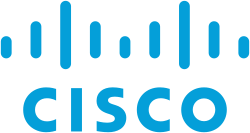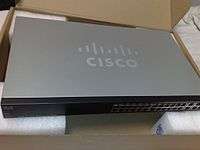List of Cisco products

Cisco Systems' products and services focus upon three market segments—enterprise and service provider, small business and the home.
Cisco has grown increasingly popular in the Asia-Pacific region over the last three decades and is the dominant vendor in the Australian market with leadership across all market segments. It uses its Australian office as one of the main headquarters for the Asia-Pacific region, offering a diverse product portfolio for long-term[1] stability, and integration is a sustainable competitive advantage.
Corporate market
"Corporate market" refers to enterprise networking and service providers.
- Enterprise networks
- Products in this category are Cisco's range of routers, switches, wireless systems, security systems, WAN acceleration hardware, energy and building management systems and media aware network equipment.[2][3]
- Collaboration
- IP video and phones, TelePresence, HealthPresence, Unified Communications, Call Center systems, Enterprise social networks and Mobile applications[4]
- Datacenter and Virtualization
- Unified Computing, Unified Fabric, Data Centre Switching, Storage Networking and Cloud Computing services.[5]
- IP NGN (Next Generation Networks)
- High-end routing and switching for fixed and mobile service provider networks, broadcast video contribution/distribution, entitlement and content delivery systems.[6]
Small businesses


Small businesses include home businesses and (usually technology-based) startups.[7]
- Routers and switches
- The machines that route and redirect packets across a network, including those for networks of smart meters.[8]
- Security and surveillance
- IP cameras, data and network security etc.[9]
- Voice and conferencing
- VOIP phones and gateway-systems, WebEx, video conferencing
- Wireless
- Indoor Wi-Fi Access points, Wireless Controller
- Network storage systems
- Persistent people storage on networks, either in the traditional sense or in a cloud-like manner.
Home user
"Home user" refers to individuals or families who require networking services in the home.[10]
- Broadband
- Broadband refers to cable modems.
- Flip Video
- With the acquisition of Pure Digital Technologies, Cisco began to sell a line of video-recording devices called "Flip Video" that had been Pure Digital's only line of products. This line of products was not as popular as Cisco had thought it would have been, and on April 12, 2011, Cisco announced they were discontinuing all Flip camera production.[11][12] Cisco's ūmi product line, video conferencing for the home, also proved to be a short-lived bid for the consumer multimedia market and sales were discontinued.[13]
Hardware


Data
- Datacenter products: Nexus Switches (1000v, 2000, 3000, 4000, 5000, 6000,7000, 9000), MDS, Unified Computing System (UCS)
- Routers, including: 800 Series, Integrated Services Router (ISR) (1800, 2800, 3800), ISR G2 (1900, 2900, 3900), 2500 Series, 7200, 7600, 12000, ASR (900, 1000, 9000), Network Convergence System (NCS) 6000, and Carrier Routing System (CRS-1, CRS-3, CRS-X)
- Security appliances: ASA 5500, PIX 500 series, Cisco Security Manager, Email Security Appliance (ESA), Web Security Appliance (WSA), Content Security Management Appliance (SMA)
- Catalyst switches: 1900 Series, 2900 / 2950 / 2960 / 3500XL Series, 3550 / 3750 Series, 3000 Series, Catalyst 4500/4900, 5000/5500 Series, 6500 Series, 6800 Series
- Teleworker/Remote Connectivity—Cisco LAN2LAN Personal Office for ISDN, VPN 3000 Concentrators
- Cisco Wireless LAN products—Access Points, PCI/PCMCIA/USB Wireless LAN Adaptors, Wireless LAN Controllers (WLC), Wireless LAN Solutions Engines (WLSE), Wireless Control System (WCS), Location Appliances, Long range antennas.
Telephony Products
- Collaboration Systems—Cisco TelePresence, (Cisco Manufacturing Mobile Video Collaboration with Librestream, Cisco acquired Tandberg, the world leader in Telepresence systems)[14]
- IP Telephony (VoIP) Servers and Appliances
- Cisco Unified IP Phones—Wireless IP Phone 7920, 7945, 7965, 7942, 8900 series, 9900 series, 6900 series
Servers / Application Appliances
- Cisco Wide Area Application Services (WAAS)
- Unified Computing: Cisco Unified Computing System (UCS) virtual server platform
- Cisco Application Control Engine (ACE): Application Delivery Controller (now discontinued)
Experimental
Other Products
- Cisco Cius: a new Android-based collaboration tablet (now discontinued)
- Set Top Boxes (High Definition PVRs)—Cable/IP
- Flip pocket camera (Discontinued in April 2011)[15]
Software
Operating Systems
- Internetwork Operating System (IOS)
- CatOS—Catalyst Switch Operating System
- NX-OS—Nexus Operating System
- IOS-XR
VPN/Remote Connectivity
- Cisco AnyConnect Secure Mobility Client
- Cisco Systems VPN Client
- Clean Access Agent, Cisco NAC Appliance
Telephony/VoIP
- Cisco CallManager / Cisco CallManager Express
- Cisco Unified Communications Manager
- Cisco Unified Operations Manager (CUOM)—is a NMS for voice. It features real-time monitoring of all system elements, and performs automatic discovery for the entire system and provides contextual diagnostics for troubleshooting.
- Cisco IP Communicator is a VoIP softphone software application. It can register with a Cisco Unified Communications Manager or Cisco Unified Communications Manager Express using either SIP or Cisco's proprietary Skinny Client Control Protocol.
- WebEx Collaboration Tools
Other
- Cisco Active Network Abstraction
- Cisco Fabric Manager
- Data Center Management and Automation—Cisco Intelligent Automation
- Cisco Tidal Enterprise Scheduler
- CiscoView
- CiscoWorks Network Management software
- Cisco Eos
- Packet Tracer, didactic network simulator
- Cisco Network Magic Pro
- Cisco Security Manager
- Cisco SDM
- PostOffice protocol (not to be confused with POP3, SMTP, or other mail delivery protocols). It is a Cisco proprietary protocol that runs over UDP on port 45000.[16] It provides a communications vehicle between the sensors and the Director platform.
VoIP services
Cisco became a major provider of Voice over IP to enterprises, and is now moving into the home user market through its acquisitions of Scientific Atlanta and Linksys. Scientific Atlanta provides VoIP equipment to cable service providers such as Time Warner, Cablevision, Rogers Communications, UPC and others; Linksys has partnered with companies such as Skype, Microsoft and Yahoo! to integrate consumer VoIP services with wireless and cordless phones.
Hosted Collaboration Solution (HCS)
Cisco partners can offer cloud-based services based on Cisco's virtualized Unified Computing System (UCS). A part of the Cisco Unified Services Delivery Solution that includes hosted versions of Cisco Unified Communications Manager (UCM), Cisco Unified Contact Center, Cisco Unified Mobility, Cisco Unified Presence, Cisco Unity Connection (unified messaging) and Cisco Webex Meeting Center.[17]
Network Emergency Response
As part of its Tactical Operations initiative, Cisco maintains several Network Emergency Response Vehicles (NERV)s.[18] The vehicles are maintained and deployed by Cisco employees during natural disasters and other public crises. The vehicles are self-contained and provide wired and wireless services including voice and radio interoperability, voice over IP, network-based video surveillance and secured high-definition video-conferencing for leaders and first responders in crisis areas with up to 3 Mbit/s of bandwidth (up and down) via a 1.8-meter satellite antenna.[19]
NERVs are based at Cisco headquarters sites in San Jose, California and at Research Triangle Park, North Carolina, allowing strategic deployment in North America. They can become fully operational within 15 minutes of arrival. High-capacity diesel fuel-tanks allow the largest vehicles to run for up to 72 hours continuously.[20] The NERV has been deployed to incidents such as the October 2007 California wildfires; hurricanes Gustav, Ike and Katrina; the 2010 San Bruno gas pipeline explosion, tornado outbreaks in North Carolina and Alabama in 2011; and Hurricane Sandy in 2012.[21][22]
The Tactical Operations team maintains and deploys smaller, more portable communication kits to emergencies outside of North America. In 2010, the team deployed to assist in earthquake recovery in Haiti and in Christchurch (New Zealand). In 2011, they deployed to flooding in Brazil, as well as in response to the 2011 earthquake and tsunami in Japan.[23][24]
In 2011, Cisco received the Innovation Preparedness award from the American Red Cross Silicon Valley Chapter for its development and use of these vehicles in disasters.[25]
References
- ↑ "CCIE Security Cisco Certified Internetwork Expert".
- ↑ "Enterprise Networks". Cisco. December 10, 2015. Retrieved August 3, 2016.
- ↑ Cisco website Borderless network products. Retrieved February 27, 2011.
- ↑ Cisco website Collaboration products and services. Retrieved February 27, 2011.
- ↑ Cisco website on Datacenter products. Retrieved February 26, 2011.
- ↑ Cisco website on IP Next-Generation Networks. Retrieved April 6, 2011.
- ↑ Products for small businesses. Retrieved February 25, 2011.
- ↑ Rick Merritt, EE Times. "Cisco rolls more routers for smart grids." January 27, 2012. Retrieved January 27, 2012.
- ↑ SME Products and services on company website. Retrieved February 27, 2011.
- ↑ Cisco Home products on company website. Retrieved February 27, 2011.
- ↑ "Catholic Online Statement about Flip Camera". CatholicOnline. March 13, 2011.
- ↑ ""World According to Jon" video about discontinuation". Jon Paula. March 12, 2011.
- ↑ "Cisco Pulls Another Flip". January 4, 2012. Retrieved March 8, 2012.
- ↑ "Tandberg product inquiry page". Tandberg.com. Retrieved February 27, 2011.
- ↑ "Cisco gives Flip video biz the boot". CNET. April 12, 2011. Retrieved August 21, 2011.
- ↑ Carter, Earl; Stiffler, Rick (2001-12-28). "Cisco Secure IDS and the PostOffice Protocol". Intrusion Detection: Cisco IDS Overview. Cisco Press. Retrieved 2012-08-04.
- ↑ "Cisco Launches Hosted Collaboration Solution". UCStrategies.com. July 2, 2010.
- ↑ "Cisco Tactical Operations (TacOps)". Cisco. Retrieved 26 July 2016.
- ↑ "Cisco Network Emergency Response Vehicle". YouTube. Retrieved July 24, 2013.
- ↑ "TACOPS — Emergency Response Vehicle Tour, learningatcisco on USTREAM. Conference". Ustream.tv. Retrieved July 24, 2013.
- ↑ 49 Days Later, Superstorm Sandy Relief Effort is Still Running on Cisco Technology. Cisco.com Retrieved January 15, 2013.
- ↑ Cisco NERV: The ultimate first responder vehicle. TechRepublic. Retrieved September 10, 2011.
- ↑ "Cisco Tactical Operations (TacOps)". Cisco. Retrieved 26 July 2016.
- ↑ "Cisco TacOps". YouTube. 2011-06-28. Retrieved July 24, 2013.
- ↑ 2011 Innovative Preparedness—Cisco Tactical Operations. Youtube.com. Retrieved September 10, 2011.